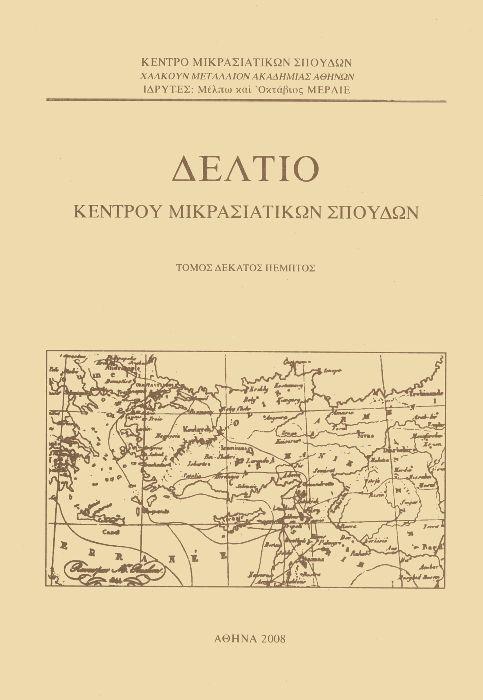Φωκαϊκά σπαράγματα
Περίληψη
The starting point for this publication of miscellaneous materials regarding
Phocaea was the discovery of the dossier of the French archaeologist Félix
Sartiaux that had been deposited in the French Archeological School in
Athens but was so far considered lost. Sartiaux excavated in the area of
Phocaea (Western Asia Minor) during the troubled years 1913-1921, a work
which, owing to the sad events of the summer of 1922, had to stop and be
resumed after the 1950s by the Turkish archaeologists Akurgal and Ozyigit.
Sartiaux was primarily interested in the archaic period of the town which
was closely associated with the Greek colonisation of the Western Mediterranean,
especially the foundation of Marseille. Yet his letters and archeological
report published here provide valuable information for later periods of the
town as well, among which the Genoese and modern periods. Furthermore,
they document the wider interest of French archeologists in claiming the
domain of Western Asia Minor for themselves and away from their German
counterparts.
The publication of Sartiaux’s dossier is supplemented here with specific
studies on the medieval history and archeology of the town. Stephanos
Efthymiadis discusses all scattered evidence concerning Byzantine Phocaea,
when the town, a rather small bishopric, was mostly known as a centre of
production of ceramics, textiles, and probably alum, a mineral that was later
commercially exploited by the Genoese (end of 13th c.- 15th c.). Its mention
in the edict of Alexios I Komnenos that granted privileges to the Venetians
(1082) and the attestation of an Amalfitan merchant as its inhabitant in the
12th century show that Phocaea began to acquire a certain economic
significance well before its concession by Michael Vili Paleologos to the
Genoese family of Zaccaria (ca. 1268). The study of Andreas Mazarakis,
“The Zaccaria in Phocaea (ca. 1268-1329),” is concerned with problems of
prosopography and the trading activity of this family. Drawing on
historiography, numismatics, and Genoese notarial documents, the author
discards previous misunderstandings and puts in order all the information
regarding the political and other activities of the Zaccaria in the Byzantine
or Frankish Levant. His four other studies concern the problems of alum
exploitation in Old Phocaea and on the adjacent island of Lesbos; the
commemorative slab of the Gattelusi, lords of Mytilene and Old Phocaea,
walled in a still standing nineteenth-century house; the anonymous Venetian
atlas MGI 1694 of the National Library of Austria, which dates from the
year 1656 and features a representation of Old Phocaea; and a note on the
property status of land-owners in Phocaea as recorded in the map drawn up
by Sartiaux in 1921.
Λεπτομέρειες άρθρου
- Πώς να δημιουργήσετε Αναφορές
-
Ευθυμιάδης Σ., & Μαζαράκης Α. (2008). Φωκαϊκά σπαράγματα. Δελτίο Κέντρου Μικρασιατικών Σπουδών, 15, 39–162. https://doi.org/10.12681/deltiokms.260
- Τεύχος
- Τόμ. 15 (2008)
- Ενότητα
- Άρθρα

Αυτή η εργασία είναι αδειοδοτημένη υπό το CC Αναφορά Δημιουργού – Μη Εμπορική Χρήση – Παρόμοια Διανομή 4.0.
Οι συγγραφείς των άρθρων που δημοσιεύονται στο Δελτίο διατηρούν τα δικαιώματα πνευματικής ιδιοκτησίας επί των άρθρων τους, δίνοντας στο περιοδικό το δικαίωμα της πρώτης δημοσίευσης. Άρθρα που δημοσιεύονται στο Δελτίο διατίθενται με άδεια Creative Commons 4.0 και σύμφωνα με την άδεια μπορούν να χρησιμοποιούνται ελεύθερα, με αναφορά στο/στη συγγραφέα και στην πρώτη δημοσίευση για μη κερδοσκοπικούς σκοπούς και με δικαίωμα τροποποίησης μόνον με παρόμοια διανομή (αν αναμείξετε, τροποποιήσετε, ή δημιουργήσετε πάνω στο υλικό, πρέπει να διανείμετε τις δικές σας συνεισφορές υπό την ίδια άδεια όπως και το πρωτότυπο).


